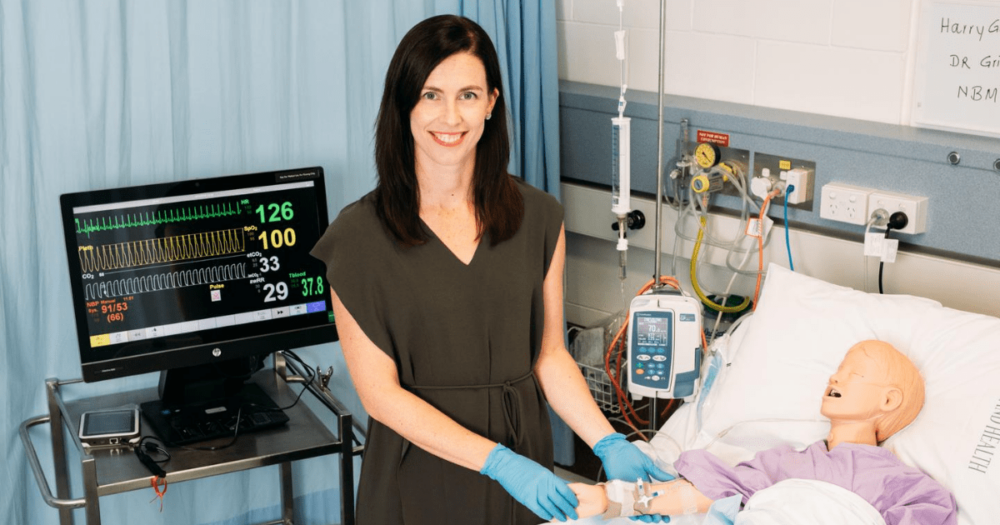Working as a paediatric intensive care nurse, Amanda UIlman felt a real sense of responsibility to ensure that her patients could receive the treatment they needed via intravenous catheters (or IVs) without healthcare-associated harm.
This responsibility has led her to build a career in research that investigates the ways in which IV practices and technologies can be optimised to ensure that children receive the treatment they need without their treatment being disrupted or resulting in IV-associated complications, such as bloodstream infections.
“In the hospital, one of the first things we do to treat our patients is to insert a needle in their vein to administer their treatment, whether that’s something straightforward like delivering fluids or antibiotics or something as complex as chemotherapy,” she says.
“As I worked mostly in intensive care, the children I saw were usually in hospital for something major – like sepsis, cancer, respiratory failure or trauma. With that in mind, I believe their IV should be the least of their worries.
“Sadly, what we know at the moment is that about 1 in 2 children who come into hospital will have some sort of harm associated with their IV. For example, trauma associated with too many insertion attempts or the IV malfunctioning and the medication being infused into their tissue rather than their bloodstream resulting in scarring, bloodstream infections and blood clots (thrombosis).”
Amanda has focused her research career on transforming how health professionals select, insert, and manage IV devices, so that from the moment a child comes into the hospital to the moment they leave, the adverse effects of IV use are prevented. While most of her projects involve IVs, they cover a wide scope, from clinician decision-making, to how IVs are made, to insertion technologies.
One of Amanda’s current projects, miniMAGIC, is an international collaboration to publish the world’s first paediatric appropriateness guidelines for intravenous catheters. Created together with Amanda’s colleagues from Menzies Health Institute Queensland and the University of Michigan, miniMAGIC rates the safety of all vascular devices for children.
“We hope our findings will improve safe decision making by clinicians, to ensure the safe, appropriate use of all types of IVs in paediatric healthcare,” she says.
“miniMAGIC deals directly with clinical decision making – we collated highly complex information into simple recommendations and have placed this guidance into the hands of all healthcare professionals.”
Through her research, Amanda’s goal is to prevent harm associated with healthcare for all children. With that in mind, two of her other current projects look at alternative ways to prevent harm associated with IV use – the materials IVs are made of, and the technologies we used to guide their insertion.
“Across three hospitals in South-East Queensland, we are currently undertaking a randomized controlled trial to see if complications and failures can be avoided by using different coatings on the plastic IV materials,” Amanda explains.
“We are comparing standard plastic IVs, with IVs coated with both anti-microbial and anti-thrombotic (blood clot) products, in over 1,000 participants.
“Within another major project (led by Professor Claire Rickard) we are avoiding traumatic experiences and pain caused when we have to make several attempts at inserting the IV. We especially struggle to insert IVs into very young children, as their veins are smaller and therefore harder to feel.
“Our team is implementing the use of ultrasound imaging, so that practitioners can see the vessel and needle tip to guide the IV directly into the vein. This project could help thousands of people who experience problems with IV insertion, such as premature babies, children, or the elderly.”
In that NHMRC funded project, Amanda is part of a large collaboration between the Gold Coast University Hospital, Queensland Children’s Hospital, and the Royal Brisbane and Women’s Hospital.
Amanda is one of many experienced researchers in paediatric nursing based at Griffith University, with these projects feeding into the School of Nursing and Midwifery’s ranking as the number one in Australia and the number two in the world. Through this expert team of clinicians and researchers, Griffith University offers Queensland’s only undergraduate, specialised stream of paediatric nursing. This sees graduates leave Griffith with not just their Bachelor of Nursing, but an additional Graduate Certificate in Paediatric Nursing.
“We have many clinicians and researchers working on developing the undergraduate programs for nursing. While for me personally it’s great being part of such a strong research team, it’s also great to be in the position where I can give back to the next generations of nurses,” says Amanda.
“With my projects, I’m able to include undergraduate nursing or honours students directly from the Griffith degrees, which is an opportunity they couldn’t find in many other universities. It’s great for me to hear from people just beginning their nursing career, but it’s also a huge benefit to the students to develop relationships within the clinical spaces where I conduct my research, like the hospitals around South East Queensland.
“This is great in any year, but particularly in 2020, which has been recognised as the WHO Year of the Nurse and the Midwife, a great recognition of the hard work of nurses and midwives across Australia and the world.”
Griffith Expert and paediatric Registered Nurse Amanda Ullman is an Associate Professor and National Health and Medical Research (NHMRC) Fellow at Griffith’s School of Nursing and Midwifery and Menzies Health Institute Queensland. She is the Paediatric and Neonates Director for the Alliance for Vascular Access Teaching and Research (AVATAR) and co-lead of the PAediaTric Teaching and Research Network (PATTERN). In 2020, she is both a doctoral and a masters supervisor for Griffith University students.
If you would like to start or further a career in nursing, join Griffith University for the Bachelor of Nursing or our wide range of post-graduate study options, such as the Master of Infection Prevention and Control and the Graduate Certificate of Acute Care Nursing.



